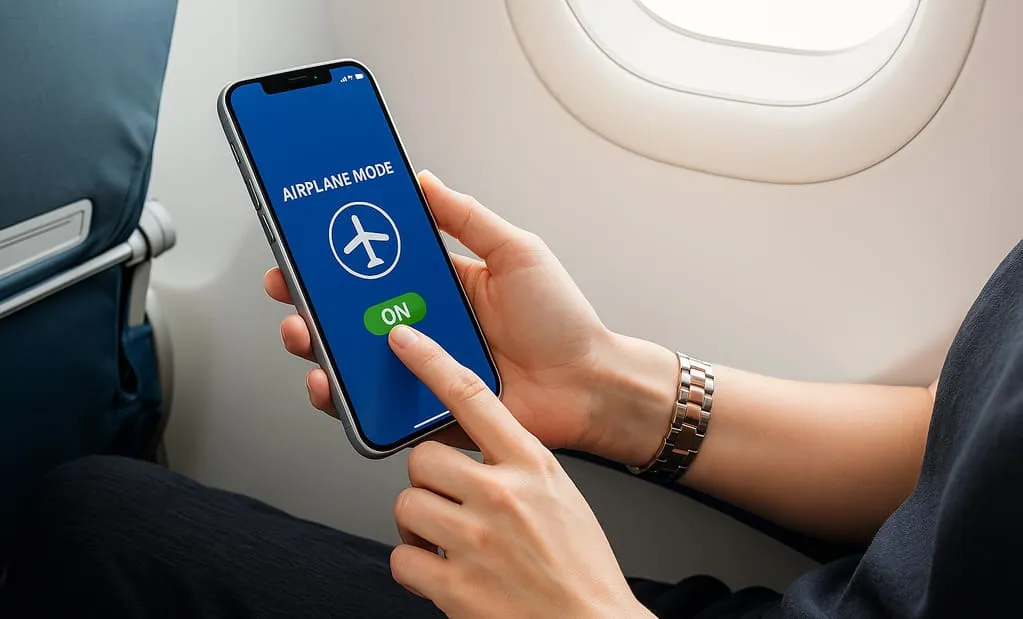Why You Really Have to Switch Your Phone to Airplane Mode
- Saturday, Apr 05, 2025, 15:20 (GMT+7)
Why You Really Have to Switch Your Phone to Airplane Mode
There’s a certain kind of stillness that sets in just before a plane takes off. The engines begin to hum, the cabin lights dim ever so slightly, and a gentle but firm voice comes over the speaker: “Please switch your devices to airplane mode.” It’s a phrase we’ve all heard a hundred times, a ritual of flying that feels more like a habit than a necessity. But have you ever truly asked yourself why?
I used to wonder that too. On my very first flight years ago, armed with nothing more than a backpack and a beat-up Nokia, I remember feeling a strange defiance. Why should I turn it off? It’s not like I’m launching a rocket. Back then, the command felt vague, even a little dramatic. But after flying across countless countries, airports, and time zones — from remote runways in Southeast Asia to the cutting-edge hubs of Europe and North America — I’ve come to learn that the answer is far more fascinating and important than it seems.
The idea that mobile phones could interfere with aircraft systems has been around since the 1990s. In the early days of mobile technology, devices were not nearly as regulated or refined as they are today. Their signals could, in some cases, interfere with navigation or communication instruments on planes. Stories of pilots hearing buzzing sounds in their headsets — later traced to a passenger’s forgotten phone — were not uncommon. In a world where precision is everything, even the smallest disruption can ripple out into something bigger.
But technology has evolved. Modern aircraft are equipped with far more resilient systems, shielded from most forms of electronic interference. So, does that mean we can ignore the rule today? Not exactly.
Here’s the truth: while your phone probably won’t cause a plane to fall out of the sky, it can still be a problem. When you leave your device in normal mode, it constantly searches for a cellular signal — reaching out to ground-based towers in a frenzied attempt to stay connected. But when you’re hurtling through the air at nearly 600 miles per hour, your phone starts pinging multiple towers at once, often across vast distances. This doesn’t just drain your battery; it can create a chaotic mess of signals that interferes with both aviation communication and ground-based cellular networks.
Imagine hundreds of phones all doing this at once. The cumulative effect could potentially disrupt sensitive avionics or create interference in the pilot’s radio communications — which, in critical moments like landing or navigating turbulent skies, is the last thing you’d want.
I once had the privilege of chatting with a commercial pilot on a long-haul flight to Tokyo. When I asked him about the airplane mode rule, he nodded seriously. “We don’t get alerted if one device is active,” he said, “but we know when there are many. And that can make a difference — not in obvious ways, but in subtle ones.” That conversation stuck with me. It reminded me that aviation is a symphony of precision. Every note — every frequency, every signal — must play in harmony.
And then there’s the regulatory side. In the United States, for instance, the Federal Communications Commission (FCC) still prohibits in-flight mobile calls using cellular networks, not only to prevent signal chaos in the skies but also to protect the integrity of networks on the ground. Meanwhile, in the European Union, airlines have begun allowing 5G connectivity during flights using specialized onboard equipment that ensures safe, isolated connections. So yes, it is possible — but only in aircraft that are properly equipped and in regions where the regulatory framework allows it.
Some of the world's most advanced airlines — like Singapore Airlines, Emirates, and Lufthansa — now offer Wi-Fi and even in-flight cellular networks on select aircraft. But even then, passengers are still instructed to activate airplane mode. Why? Because their systems want to manage your connectivity through their own infrastructure, rather than have devices running amok trying to connect with the outside world.
And then there’s the social aspect — the unspoken etiquette of being 35,000 feet in the air with hundreds of other people. In the United States, even if technology allowed for midair phone calls, the idea has sparked debate. Imagine being seated next to someone loudly discussing their work emails or personal drama for an entire six-hour flight. Not exactly the dream travel scenario.
But beyond the science, the rules, and the tech, there’s something else. Something quieter. Airplane mode gives us a rare window to disconnect. In a world obsessed with endless notifications, scrolling, and digital noise, those few hours offline can feel almost sacred. No pings, no vibrations, no dopamine hits from likes or messages — just the soft hum of the engine and a sense of stillness that’s hard to find on the ground.
I’ve come to treasure that time. Somewhere over the Indian Ocean, or above the snowy tips of the Alps, when the cabin lights are low and everyone is half-asleep, I find myself reconnecting not with the internet, but with my own thoughts. Reading a book, journaling, reflecting. Airplane mode, in its own quiet way, becomes a kind of mindfulness switch.
So yes, turn your phone to airplane mode. Not because it’s a silly rule, but because it matters. Because thousands of engineers, pilots, and regulators have studied this deeply and concluded: this is the best way to keep everyone safe. And because, perhaps most importantly, it offers you a fleeting, beautiful chance to pause — to truly fly, not just across the sky, but within yourself.

 CHECKIN.VN
CHECKIN.VN








Share on